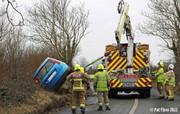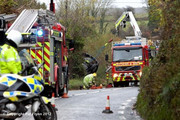- Joined
- Jun 19, 2015
- Messages
- 69
Hey guys,
since my Paint artwork was so well received and some of you showed some interest in
german apparatus I thought I could share some of my photos of them.
Photography is another hobby of mine.
I'am not a pro but I hope you enjoy the pictures.
Rescue-Engine/Pumper (Stuttgart Career-Fire-Department)
Year of manufacture: 2012
Pump: 528 gal./min
Tank: 528 gal. water and 52 gal. Class-A-Foam
Carries: Fire fighting equipment , Jaws of Life and basic rescue-equpiment


Light- and Heavy- Rescue-Truck (T?bingen volunteer FD)
Light Rescue:
Year of manufacture: 1992
26 gal tank with AFFF (Light-Water)
Carries: Jaws of life and basic rescue equipment
Heavy Rescue:
Year of manufacture: 1985
Carries: Jaws of life and advanced rescue equipment for water-rescue/hazmat situations and building collapses.


Mobile Cranes (Reutlingen Career-Fire-Department)
Year of manufacture: 2014 / 1989
Used for: Heavy rescues such as person pinned under a truck/train etc.


Airport Rescue and Firefighting Vehicle (ARFF) (Stuttgart Airport Fire-Department)
Year of manufacture: 2002
Pump: 1585 gal./min
Tank: 3302 gal. water , 396 gal. AFFF and 595 lb carbon dioxide.
Carries: First-Attack Fire fighting-Equipment


Rescue-Engine/Pumper (Stuttgart Airport Fire-Department)
Year of manufacture: 2002
Pump: 634 gal./min
Tank: 634 gal. water
Carries: Fire fighting equipment , Jaws of Life and basic rescue-equpiment


Emergency-Physician-Car and Ambulance (Stuttgart Career-Fire-Department)
Year of manufacture: 2006/2012
They carry: Advanced Life support equipment ( Defibrillator,Suction-Pump,Respirator,Spine Board,KED-System,Drugs etc.)


Kind regards Christoph 51
since my Paint artwork was so well received and some of you showed some interest in
german apparatus I thought I could share some of my photos of them.
Photography is another hobby of mine.
I'am not a pro but I hope you enjoy the pictures.
Rescue-Engine/Pumper (Stuttgart Career-Fire-Department)
Year of manufacture: 2012
Pump: 528 gal./min
Tank: 528 gal. water and 52 gal. Class-A-Foam
Carries: Fire fighting equipment , Jaws of Life and basic rescue-equpiment


Light- and Heavy- Rescue-Truck (T?bingen volunteer FD)
Light Rescue:
Year of manufacture: 1992
26 gal tank with AFFF (Light-Water)
Carries: Jaws of life and basic rescue equipment
Heavy Rescue:
Year of manufacture: 1985
Carries: Jaws of life and advanced rescue equipment for water-rescue/hazmat situations and building collapses.


Mobile Cranes (Reutlingen Career-Fire-Department)
Year of manufacture: 2014 / 1989
Used for: Heavy rescues such as person pinned under a truck/train etc.


Airport Rescue and Firefighting Vehicle (ARFF) (Stuttgart Airport Fire-Department)
Year of manufacture: 2002
Pump: 1585 gal./min
Tank: 3302 gal. water , 396 gal. AFFF and 595 lb carbon dioxide.
Carries: First-Attack Fire fighting-Equipment


Rescue-Engine/Pumper (Stuttgart Airport Fire-Department)
Year of manufacture: 2002
Pump: 634 gal./min
Tank: 634 gal. water
Carries: Fire fighting equipment , Jaws of Life and basic rescue-equpiment


Emergency-Physician-Car and Ambulance (Stuttgart Career-Fire-Department)
Year of manufacture: 2006/2012
They carry: Advanced Life support equipment ( Defibrillator,Suction-Pump,Respirator,Spine Board,KED-System,Drugs etc.)


Kind regards Christoph 51






















